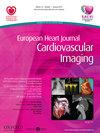Tracking multi-organ treatment response in systemic AL amyloidosis with cardiac magnetic resonance derived extracellular volume mapping
引用次数: 0
Abstract
Abstract Funding Acknowledgements Type of funding sources: None. Background Systemic light-chain (AL) amyloidosis commonly involves the liver, spleen and heart. Cardiac magnetic resonance (CMR) with extracellular volume (ECV) mapping has demonstrated accuracy in measuring cardiac, hepatic and splenic amyloid infiltration. Purpose We sought to: (1) assess the association between baseline multi-organ ECVs and prognosis (2) assess the multi-organ response to treatment using ECV mapping, and (3) assess the association between multi-organ treatment response and prognosis. Methods We identified 351 patients with a confirmed diagnosis of systemic AL amyloidosis who underwent baseline serum amyloid P component (SAP) scintigraphy and CMR at diagnosis, of which 171 had follow-up imaging. We also recruited 20 healthy volunteers who underwent CMR with ECV mapping, without corresponding SAP scintigraphy, to allow calculation of the ECV normal ranges. Results At diagnosis, ECV mapping demonstrated that 304(86.7%) had cardiac involvement, 114(32.5%) significant hepatic involvement and 147(41.9%) significant splenic involvement. Baseline myocardial and liver ECV independently predict mortality (myocardial: HR=1.05,95CI%[1.03–1.07],P<0.001; liver: HR=1.03,95%CI[1.01–1.05],P<0.001). Liver and spleen ECV correlated with amyloid load assessed by SAP scintigraphy (R=0.751,P<0.001; R=0.765,P<0.001, respectively). Serial multi-organ ECV measurements accurately tracked treatment response as validated against serial SAP scintigraphy (the current reference standard). Multi-organ ECV regression was observed as early as 6-months in patients with a good haematological response (liver=15%, spleen=15%, heart=5%). The remaining patients with a good haematological response had stable liver and spleen ECVs, but 20% had cardiac progression. By 12-months more patients with a good haematological response demonstrated cardiac regression (liver=30%, spleen=36%, heart=32%), and this trend was maintained at 24-months. Multi-variable analysis adjusting for haematological response, change in myocardial, liver and spleen ECV demonstrated that haematological response, change in myocardial ECV (HR=1.11, 95%CI[1.02–1.19], P=0.011) and liver ECV (HR=1.06, 95%CI[1.01–1.11], P=0.015) remained independent predictors of prognosis at 6-months. Conclusions Multi-organ ECV quantification accurately tracks treatment response, and demonstrates different rates of organ regression, with the liver and spleen regressing more rapidly than the heart. A good haematological response alone is likely to induce visceral organ stabilisation/regression, but may not be sufficient to induce myocardial stabilisation/regression. Liver and myocardial ECV at diagnosis and changes in ECV at 6-months independently predict mortality. ECV mapping offers a comprehensive multi-organ assessment of treatment response and accurate prognostication.利用心脏磁共振衍生的细胞外体积定位追踪系统性AL淀粉样变性的多器官治疗反应
资金来源类型:无。背景:系统性轻链淀粉样变性通常累及肝脏、脾脏和心脏。心脏磁共振(CMR)与细胞外体积(ECV)作图已证明准确测量心脏,肝脏和脾脏淀粉样蛋白浸润。我们试图:(1)评估基线多器官ECV与预后之间的关系;(2)评估使用ECV作图的多器官对治疗的反应;(3)评估多器官治疗反应与预后之间的关系。方法选取351例确诊为全身性AL淀粉样变性的患者,在诊断时进行基线血清淀粉样蛋白P成分(SAP)显像和CMR检查,其中171例进行了随访。我们还招募了20名健康志愿者,他们在没有相应的SAP显像的情况下进行了CMR的ECV测绘,以计算ECV的正常范围。结果诊断时,ECV显像显示304例(86.7%)有心脏受累,114例(32.5%)有肝脏受累,147例(41.9%)有脾脏受累。基线心肌和肝脏ECV独立预测死亡率(心肌:HR=1.05, 95% ci %[1.03-1.07],P<0.001;肝脏:HR = 1.03, 95% ci (1.01 - -1.05), P&肝移植;0.001)。肝和脾ECV与SAP显像评估的淀粉样蛋白负荷相关(R=0.751, p < 0.01;R = 0.765, P&肝移植;分别为0.001)。系列多器官ECV测量准确地跟踪治疗反应,并根据系列SAP扫描图(当前参考标准)进行验证。血液学反应良好(肝脏=15%,脾脏=15%,心脏=5%)的患者早在6个月时就观察到多器官ECV消退。其余血液学反应良好的患者有稳定的肝脏和脾脏ecv,但20%有心脏进展。到12个月时,更多血液学反应良好的患者表现出心脏退化(肝脏=30%,脾脏=36%,心脏=32%),这一趋势在24个月时保持不变。校正血液学反应、心肌、肝脏和脾脏ECV变化的多变量分析显示,血液学反应、心肌ECV变化(HR=1.11, 95%CI[1.02-1.19], P=0.011)和肝脏ECV (HR=1.06, 95%CI[1.01-1.11], P=0.015)仍然是6个月预后的独立预测因子。结论多脏器ECV定量能准确追踪治疗反应,显示出不同的脏器退化率,肝脏和脾脏的退化速度快于心脏。仅良好的血液学反应可能诱导内脏器官稳定/消退,但可能不足以诱导心肌稳定/消退。诊断时肝脏和心肌ECV以及6个月时ECV的变化独立预测死亡率。ECV制图提供了一个全面的多器官评估治疗反应和准确的预后。
本文章由计算机程序翻译,如有差异,请以英文原文为准。
求助全文
约1分钟内获得全文
求助全文

 求助内容:
求助内容: 应助结果提醒方式:
应助结果提醒方式:


